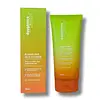What's inside
What's inside
 Key Ingredients
Key Ingredients

 Benefits
Benefits

 Concerns
Concerns

 Ingredients Side-by-side
Ingredients Side-by-side

Water
Skin ConditioningAmmonium Lauryl Sulfate
CleansingLauryl Glucoside
CleansingGlycerin
HumectantPalm Kernelamide DEA
EmulsifyingAcrylates/C10-30 Alkyl Acrylate Crosspolymer
Emulsion StabilisingCentella Asiatica Leaf Extract
Skin ConditioningChamomilla Recutita Flower Extract
MaskingSalicylic Acid
MaskingCalendula Officinalis Flower Extract
MaskingGluconolactone
Skin ConditioningHydroxyethylcellulose
Emulsion StabilisingPolyquaternium-7
Panthenol
Skin ConditioningLactobacillus Ferment
Skin ConditioningMaltodextrin
AbsorbentPhenoxyethanol
PreservativeEthylhexylglycerin
Skin ConditioningWater, Ammonium Lauryl Sulfate, Lauryl Glucoside, Glycerin, Palm Kernelamide DEA, Acrylates/C10-30 Alkyl Acrylate Crosspolymer, Centella Asiatica Leaf Extract, Chamomilla Recutita Flower Extract, Salicylic Acid, Calendula Officinalis Flower Extract, Gluconolactone, Hydroxyethylcellulose, Polyquaternium-7, Panthenol, Lactobacillus Ferment, Maltodextrin, Phenoxyethanol, Ethylhexylglycerin
Water
Skin ConditioningAmmonium Lauryl Sulfate
CleansingSodium Cocoyl Alaninate
Cocamidopropyl Betaine
CleansingAcrylates/C10-30 Alkyl Acrylate Crosspolymer
Emulsion StabilisingButylene Glycol
HumectantLactic Acid
BufferingPEG-8
HumectantSodium Hydroxide
BufferingMelia Azadirachta Leaf Extract
Skin ConditioningPropylene Glycol
HumectantGluconolactone
Skin ConditioningMandelic Acid
AntimicrobialCentella Asiatica Leaf Extract
Skin ConditioningSalicylic Acid
MaskingDextrin
AbsorbentPolydextrose
HumectantAmylopectin
Niacinamide
SmoothingMethylchloroisothiazolinone
PreservativeMethylisothiazolinone
PreservativePhenoxyethanol
PreservativeWater, Ammonium Lauryl Sulfate, Sodium Cocoyl Alaninate, Cocamidopropyl Betaine, Acrylates/C10-30 Alkyl Acrylate Crosspolymer, Butylene Glycol, Lactic Acid, PEG-8, Sodium Hydroxide, Melia Azadirachta Leaf Extract, Propylene Glycol, Gluconolactone, Mandelic Acid, Centella Asiatica Leaf Extract, Salicylic Acid, Dextrin, Polydextrose, Amylopectin, Niacinamide, Methylchloroisothiazolinone, Methylisothiazolinone, Phenoxyethanol
 Reviews
Reviews

Ingredients Explained
These ingredients are found in both products.
Ingredients higher up in an ingredient list are typically present in a larger amount.
Acrylates/C10-30 Alkyl Acrylate Crosspolymer is a synthetic polymer. It is used to thicken and improve the texture of products. Due to its properties, it can prevent water and oil ingredients from separating.
Ammonium Lauryl Sulfate is a type of sulfate. It can be bad for dry skin, be bad for oily skin, and cause irritation.
Centella Asiatica Leaf Extract comes from the leaves of an herb plant native to Southeast Asia. Centella Asiatica is rich in antioxidants and amino acids. It can help reduce irritation and soothe the skin.
Many active components found in centella asiatica, such as Madecassic Acid and Asiaticoside, encourage the skin to naturally produce hyaluronic acid. This helps keep our skin hydrated. Many of these components also show antioxidant activity and may help reduce the signs of aging.
Research shows centella asiatica can help increase Type I collagen production by increasing fibroblast production. Fibroblast helps form connective tissue.
The combination of all these properties makes centella asiatica leaf extract effective at soothing the skin.
Other components of centella asiatica leaf extract include Vitamin A, vitamin C, several B vitamins, and Asiatic Acid.
Recent studies found madecassoside may help prevent damage from UV rays by preventing UV-induced inflammation. Further research is needed.
This plant has been used as a medicine and in food for many centuries. As a medicine, it is used to treat burns, scratches, and wounds.
Learn more about Centella Asiatica Leaf ExtractGluconolactone is a PHA. PHAs are a great gentle alternative to traditional AHAs.
When applied, Gluconolactone has the same affect on skin as AHAs such as lactic acid. It helps dissolve the dead skin cells in the top layer of your skin. This improves texture and brightens the skin.
PHAs are more gentle than AHAs due to their larger structure. They do not penetrate as deeply as AHAs and take a longer time to dissolve dead cells. Studies show PHAs do not cause as much irritation.
Gluconolactone has some interesting properties:
In a 2004 study, Gluconolactone was found to prevent UV damage in mouse skin cells and has not been found to increase sun sensitivity. However, we still recommend wearing SPF daily.
This ingredient is is an created by reacting gluconic acid with an alcohol.
Learn more about GluconolactonePhenoxyethanol is a preservative that has germicide, antimicrobial, and aromatic properties. Studies show that phenoxyethanol can prevent microbial growth. By itself, it has a scent that is similar to that of a rose.
It's often used in formulations along with Caprylyl Glycol to preserve the shelf life of products.
Salicylic Acid (also known as beta hydroxy acid or BHA) is a well-known ingredient for treating skin that struggles with acne and clogged pores. It exfoliates both the skin's surface and deep within the pores to help clear out buildup, control oil, and reduce inflammation.
Unlike AHAs (alpha hydroxy acids), salicylic acid is oil-soluble. This allows it to penetrate into pores which makes it especially effective for treating blackheads and preventing future breakouts.
Salicylic acid is also known for its soothing properties. It has a similar structure to aspirin and can calm inflamed or irritated skin, making it a good option for acne-prone skin that is also sensitive.
Concentrations of 0.5-2% are recognized by the U.S. FDA as an over-the-counter topical acne product.
It can cause irritation and/or dryness if one's skin already has a compromised moisture barrier, so it's best to focus on repairing that before introducing this ingredient into your routine.
While salicylic acid does not increase sun sensitivity, it’s still important to wear sunscreen daily to protect your skin.
If you are looking for the ingredient called BHA or Butylated Hydroxyanisole, click here.
Learn more about Salicylic AcidWater. It's the most common cosmetic ingredient of all. You'll usually see it at the top of ingredient lists, meaning that it makes up the largest part of the product.
So why is it so popular? Water most often acts as a solvent - this means that it helps dissolve other ingredients into the formulation.
You'll also recognize water as that liquid we all need to stay alive. If you see this, drink a glass of water. Stay hydrated!
Learn more about Water